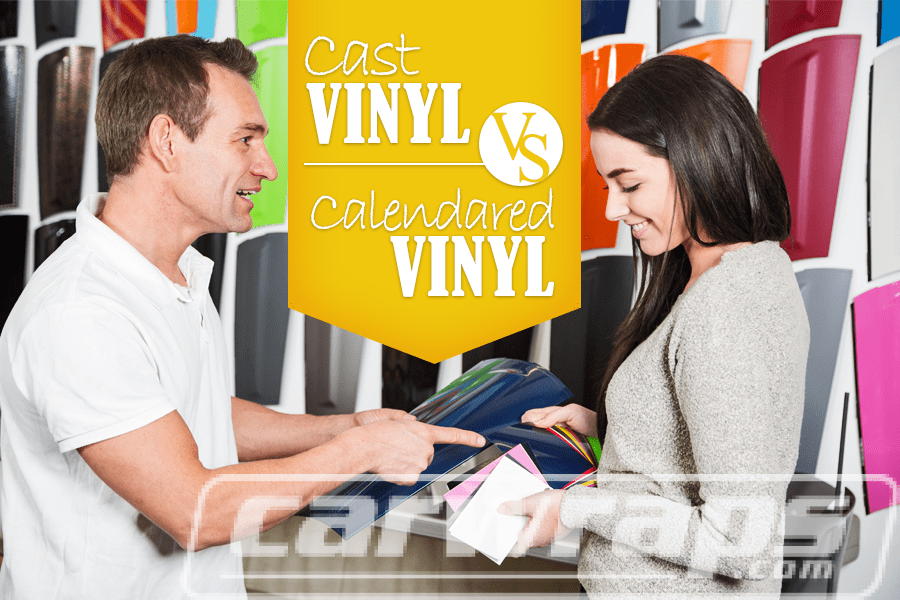We use the terms “cast” and “calendared” to refer to the grade of the film used. In simpler terms, however, it refers to the manufacturing process a film went through. Cast films are also considered as the premium type of film while calendared films are considered as the economy type.
Cast vinyl is ideal for a full vehicle wrap and is not advisable for a vehicle wrap that will be used for only a few months (as you may be wasting your money). On the other hand, calendared vinyl is ideal for short-term use and is not advisable for a full vehicle wrap intended for long-term use. In this article we aim to explain in depth the difference between the two.
The Basics of Vinyl
Let’s begin with the basics. Vinyl films are made from raw materials such as polyvinylchloride (PVC) polymer. This material is simply the basic plastic, which is rigid by nature. Other materials are added to it such as plasticizer, coloring pigment and additives. All these ingredients, such as heat stabilizers, processing aids and fillers, work together to achieve specific vinyl properties.
These materials come in a variety of quality levels. For a film with limited durability, the least expensive materials are used. For the finest ones, on the other hand, the most expensive raw materials are used in order to achieve excellent quality.
Aside from the quality of the material, the manufacturing process also affects the overall quality of the film. A vinyl is manufactured in two ways: casting or calendaring. These two processes render different film qualities. With casting, the grade of plasticizer used makes the film flexible and improves its properties. A choice is made between monomeric or polymeric plasticizer. So as not to go further into plasticizers, let’s just say that the monomeric is the economy grade and the polymeric is the higher grade plasticizer. The combination of the raw materials and these factors determines the quality of the finished product.
Cast Film
“Casting” refers to the manufacturing process of the vinyl. The process is a lot similar to baking a cake. The materials are mixed in a bowl at a predetermined time and order to achieve consistent mixture.
The liquid mixture is then cast onto a sheet and then “baked” through a series of ovens that allow the solvents to evaporate. Once all the solvents have evaporated completely, a film is left behind. This film is rolled out for subsequent adhesive coating.
The casting of the vinyl on the sheet puts it in a relaxed state and provides dimensional stability. The process also makes the vinyl thin yet durable enough when used. Film manufacturers recommend cast vinyl to customers that look for a paint-like finish.
Advantages of Using Cast Film
• It is generally more durable than other types of vinyl film because of the raw materials used and the manufacturing process it goes through.
• It is less likely to shrink over time.
• Cast films are very thin, which means that they are conformable even in complex curves, corrugations and substrates with rivets.
• Cast film is typically less vulnerable to rough forces.
• It maintains its color and other physical properties compared to other types of vinyl.
• The manufacturing process makes small productions possible. It also makes it easier to change colors during production so that it matches your expectations.
Calendared Vinyl
Just like cast vinyl, calendared vinyl also got its name from the manufacturing process it goes through. The process is just like mixing and rolling out the dough for a pie. It has almost similar raw materials as cast vinyl—only that these ingredients are mixed and “kneaded” inside the extruder. However, instead of the usual rolling pin, huge steel rollers are used to form thin sheets of vinyl.
The raw materials for a calendared film include PVC powder, color pigments and liquid softener.
Advantages of Using Calendared Film
• They have better conformability. New technology allows them to be glossier and thinner nowadays compared to those calendared films produced several years ago.
• Less cost, greater production yield
• Excellent performance on flat surfaces and simple curves
• Shrinkage can be as low as 2 to 3% depending on the type of calendared film used
• Although not as resistant to abrasion as cast film, the formulation of today’s calendared films have increased resistance to abrasion.
As with anything else in the world, a product is only as good as what you put into it. An awesome vehicle wrap begins with choosing the right materials for your project. Now that you know the difference between a cast vinyl and a calendared vinyl, we bet you’re now ready to start with your car wrap project!

